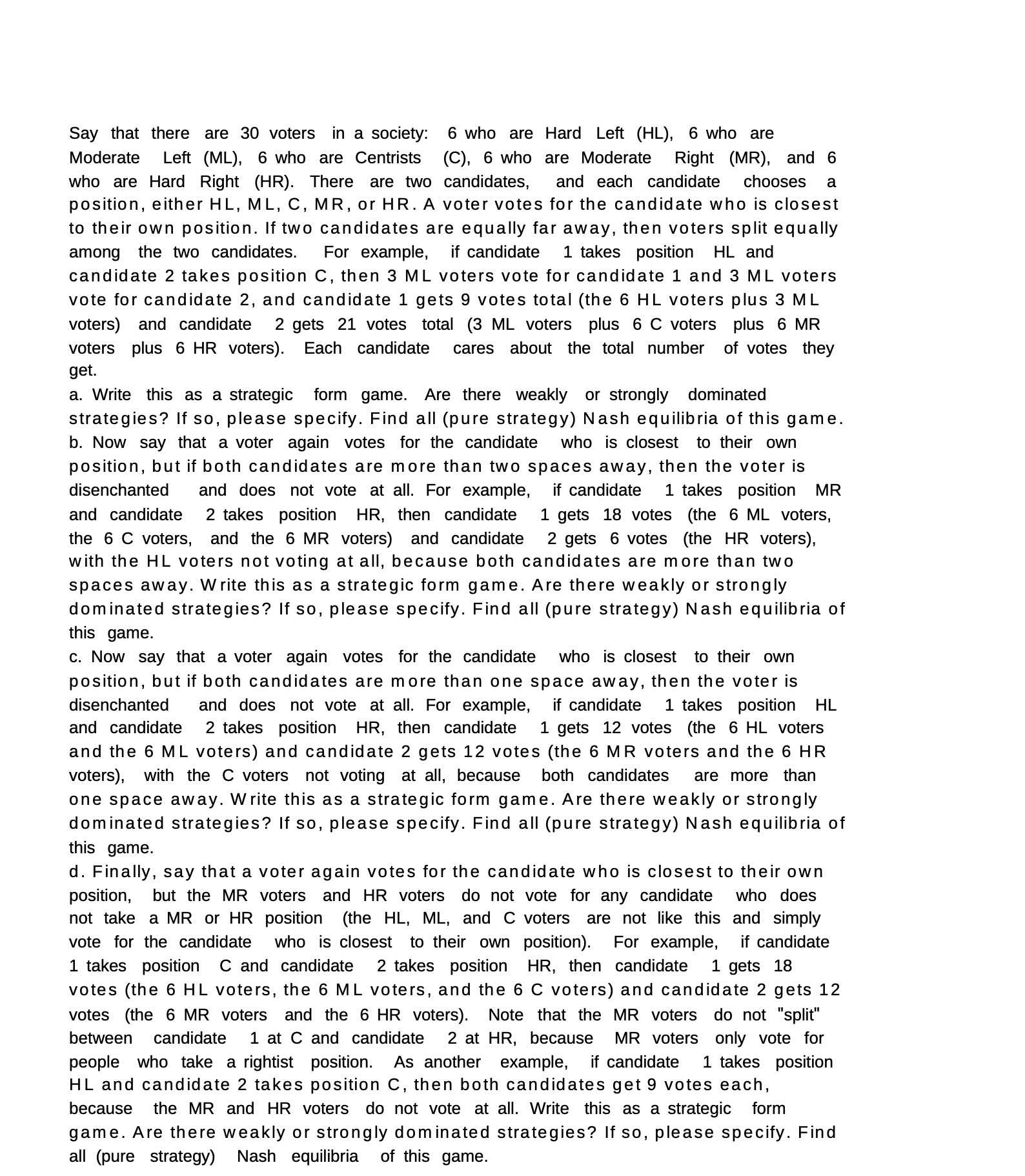
Say that there are 30 voters in a society: 6 who are Hard Left (HL), 6 who are Moderate Left (ML), 6 who are Centrists (C), 6 who are Moderate Right (MR), and 6 who are Hard Right (HR). There are two candidates, and each candidate chooses a position, either HL, ML, C, MR, or HR. A voter votes for the candidate who is closest to their own position. If two candidates are equally far away, then voters split equally among the two candidates. For example, if candidate 1 takes position HL and candidate 2 takes position C, then 3 ML voters vote for candidate 1 and 3 ML voters vote for candidate 2, and candidate 1 gets 9 votes total (the 6 HL voters plus 3 ML voters) and candidate 2 gets 21 votes total (3 ML voters plus 6 C voters plus 6 MR voters plus 6 HR voters). Each candidate cares about the total number of votes they get. a. Write this as a strategic form game. Are there weakly or strongly dominated strategies? If so, please specify. Find all (pure strategy) Nash equilibria of this game. b. Now say that a voter again votes for the candidate who is closest to their own position, but if both candidates are more than two spaces away, then the voter is disenchanted and does not vote at all. For example, if candidate 1 takes position MR and candidate 2 takes position HR, then candidate 1 gets 18 votes (the 6 ML voters, the 6 C voters, and the 6 MR voters) and candidate 2 gets 6 votes (the HR voters), with the HL voters not voting at all, because both candidates are more than two spaces away. Write this as a strategic form game. Are there weakly or strongly dominated strategies? If so, please specify. Find all (pure strategy) Nash equilibria of this game. c. Now say that a voter again votes for the candidate who is closest to their own position, but if both candidates are more than one space away, then the voter is disenchanted and does not vote at all. For example, if candidate 1 takes position HL and candidate 2 takes position HR, then candidate 1 gets 12 votes (the 6 HL voters and the 6 ML voters) and candidate 2 gets 12 votes (the 6 MR voters and the 6 HR voters), with the C voters not voting at all, because both candidates are more than one space away. Write this as a strategic form game. Are there weakly or strongly dominated strategies? If so, please specify. Find all (pure strategy) Nash equilibria of this game. d. Finally, say that a voter again votes for the candidate who is closest to their own position, but the MR voters and HR voters do not vote for any candidate who does not take a MR or HR position (the HL, ML, and C voters are not like this and simply vote for the candidate who is closest to their own position). For example, if candidate 1 takes position C and candidate 2 takes position HR, then candidate 1 gets 18 votes (the 6 HL voters, the 6 ML voters, and the 6 C voters) and candidate 2 gets 12 votes (the 6 MR voters and the 6 HR voters). Note that the MR voters do not "split" between candidate 1 at C and candidate 2 at HR, because MR voters only vote for people who take a rightist position. As another example, if candidate 1 takes position HL and candidate 2 takes position C, then both candidates get 9 votes each, because the MR and HR voters do not vote at all. Write this as a strategic form game. Are there weakly or strongly dominated strategies? If so, please specify. Find all (pure strategy) Nash equilibria of this game








